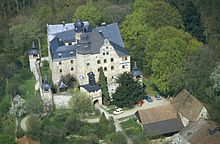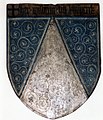Künsberg
Künsberg (also Kuenssberg and Kuenssberg) is the name of an influential knight sex in Upper Franconia , which initially his power from his ancestral castle child Berg at Creussen exercised.
history
Family members of those von Künsberg took part in military campaigns; among others the Meranians . Other employers were the bishopric of Bamberg and the margraves of Brandenburg-Kulmbach / -Bayreuth from the house of Hohenzollern . The imperial knight Heinrich von Künsberg was mentioned in 1217 as a tenant of the Staufer in Eger ( Cheb ) at the Kinsberg castle in Egerland , which is named after him .

Wernstein Castle has belonged to the family since before 1376 . In 1623 Christian von Brandenburg-Bayreuth awarded the Wernstein line the "Hereditary Marshal's Office above Gebürg" from the burgrave of Nuremberg . In 1690/91 she was confirmed as a baron.
Weidenberg was acquired in 1446 and held until 1634/1651. Oberlangenstadt Castle, acquired around 1625, is still owned by the family. From 1565 the Thurnau Castle was jointly owned with the Counts of Giech (until 1731). Ermreuth was family-owned from 1632 to 1858.
From 1476 to 1676 eight members of the family were members of the Würzburg cathedral chapter . Family representatives also held prestigious positions in the Order of St. John . Important representatives were the Würzburg cathedral capitular and district judge of the Duchy of Eastern Franconia , Georg Heinrich von Künsberg († 1676), and Karl-Dietrich von Künsberg zu Schernau, chamberlain in the service of Kurmainz and Bamberg, court counselor, chief stable master and court marshal as well as councilor in two knightly cantons.
During the Second World War, the Künsberg Sonderkommando under Eberhard von Künsberg (1909–1945) systematically captured art in the occupied countries and brought it to Germany.
people
middle Ages
- Künsberger knights in the knight canton of Gebürg and knight canton Steigerwald
- Ulrich von Kinsberg, member of the Teutonic Order in German Eylau
- Elisabeth von Künsberg († 1484), abbess in Himmelkron monastery and builder of the cloister there
Modern times
- Caroline Countess von Holnstein (1815-1859) born. Freiin von Spiering, lover and later wife of Wilhelm Freiherrn von Künsberg-Mandel (1801–1874). Their children, Wilhelm, Wilhelmine, Friedrich, Rudolf and Ida, were only legitimized under the name of Künsberg Freiherren von Fronberg in 1857, after the couple officially married in Schwandorf. Countess Holnstein's portrait is one of the best-known of the 36 portrait paintings in the beauty gallery of King Ludwig I in Nymphenburg Palace .
- Antonietta Cornelia Freifrau von Künßberg, née Vetterlein from Bayreuth, born in Münchberg , wife of Franz Ludwig Friedrich from the Künsberg- Hain line . Her portrait also hangs in the beauty gallery in Nymphenburg Palace.
- Carl Freiherr von Künsberg-Langenstadt , district president from 1849 to 1863, honorary citizen of the city of Regensburg in 1856
- Karoline Wilhelmine von Künsberg, author of a historical novel about Runding Castle
- Sophie von Künsberg (1861–1938), writer, born in Karlsbad
- Eberhard von Künßberg (1881–1941), legal historian
- Eberhard Freiherr von Künsberg (1909–1945), National Socialist (see Sonderkommando Künsberg )
- Heinrich von Künßberg (1801–1862), lawyer , historian and member of the Frankfurt National Assembly
- Franz Karl Julius von Künsberg (1813–1873), major in the Landwehr, officer a la Suite
- Wilhelm von Künsberg (1826–1895), administrative lawyer, chairman of the Protestant consistory in Bayreuth
- Martina Künsberg Sarre (* 1976), Austrian politician ( NEOS ) and member of the National Council
Tomb of Abbess Elisabeth von Künsberg († 1484) in Himmelkron Monastery
Lieutenant Johann Ludwig von Künsberg zu Weidenberg (1625–1659) as an altar figure in the cemetery church in Weidenberg
Countess Caroline von Holnstein b. Baroness von Spiering, second wife Baroness von Künsberg
Possessions

- Altenkünsberg ( Kindberg ) near Creußen is considered the former headquarters of the Künsberg family
- Kinsberg Castle in the Egerland, owned by the family around 1217
- Wernstein Castle (family-owned since before 1376 until today)
- Upper and Lower Weidenberg Castle (1446–1634 / 1651)
- Thurnau Castle (1565–1731, jointly owned by the Counts of Giech )
- Oberlangenstadt Castle (family-owned since approx. 1625)
- Nagel Castle (owned together with Oberlangenstadt from 1625, passed to the Vormbrock family by inheritance)
- Ermreuth Castle (1632-1858)
- Schmeilsdorf Castle (1398–1847)
- Moated Castle Tüschnitz (from approx. 1626)
- Bremen headquarters in Nuremberg- Mögeldorf (1668–1684)
- Manor Obersteinbach near Neustadt / Aisch (1765–1862)
- Gut Guttenthau (1748-19th century)
- Fronberg Castle (1837–1875)
- Gut Krummennaab (1865-1897)
- Charlottenhof Palace (Schwandorf) (1873–1890)
coat of arms
The coat of arms shows a silver curved tip in blue. The crest consists of a flat red hat with a silver hood, from which two red buffalo horns grow, each with an acorn at the tip.
The coat of arms of the former municipality of Oberlangenstadt also reminds of the gender.
Coat of arms of the municipality of Emtmannsberg
Family coat of arms of those of Lindenfels and von Künsberg above the gate frame of Thumsenreuth Castle
Coat of arms of those von Künsberg in Siebmacher's book of arms
The von Künsberg in the Teutonic Order : Aufschwörschild in the Nuremberg Jakobskirche
Coat of arms according to Scheibler's book of arms
Coat of arms in the Ingeram Codex
Coat of arms on the burial chapel in Mockersdorf
Coat of arms in the grave chapel of those von Künsberg in Mockersdorf
See also
literature
- Uso Künßberg: History of the Künßberg-Thurnau family. Franz, Munich 1838 ( digitized version )
- Alban von Dobenck : History of the extinct line of those von Sparneck (part 1) . In: Archive for the history of Upper Franconia 1905, issue 3, pp. 1–65
- Richard Winkler: Bayreuth - City and Altlandkreis . Commission for Bavarian State History, Munich 1999, ISBN 3-7696-9696-4 , ( Historical Atlas of Bavaria Part Franconia, Series 1, Issue 30), (At the same time: Erlangen-Nürnberg, Univ., Diss., 1994: Herrschaft und Verwaltung in the Bayreuth area from the beginning to the present )
- Gustav Voigt: The nobility on the Obermain in Die Plassenburg - Writings for local research and cultural maintenance in East Franconia , Bd. 28, Kulmbach 1969
Web links
- The story of the von Künsberg family from Dr. Albert Elstner
- Coat of arms and history of the Künsbergers
- Further historical view of the coat of arms in the coat of arms book
Individual evidence
- ↑ Künsberg possessions
- ↑ History of the Obersteinbach Manor ( Memento of the original from March 4, 2016 in the Internet Archive ) Info: The archive link was inserted automatically and has not yet been checked. Please check the original and archive link according to the instructions and then remove this notice. (PDF; 33 kB)















